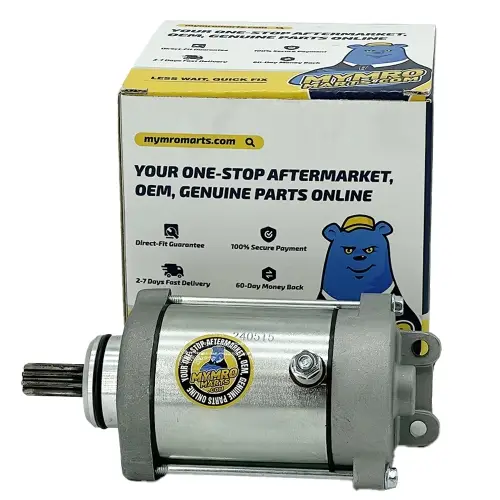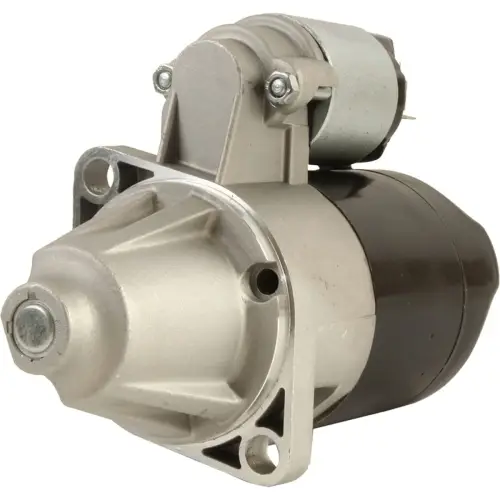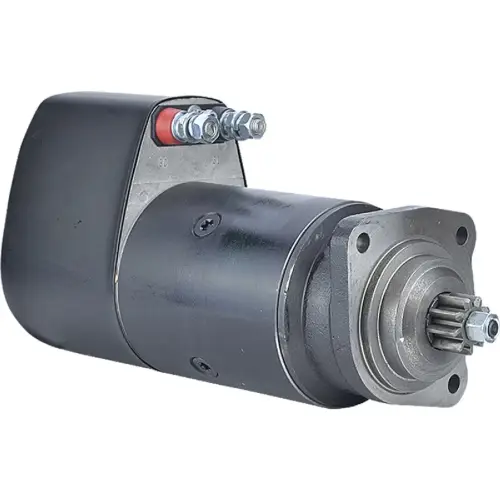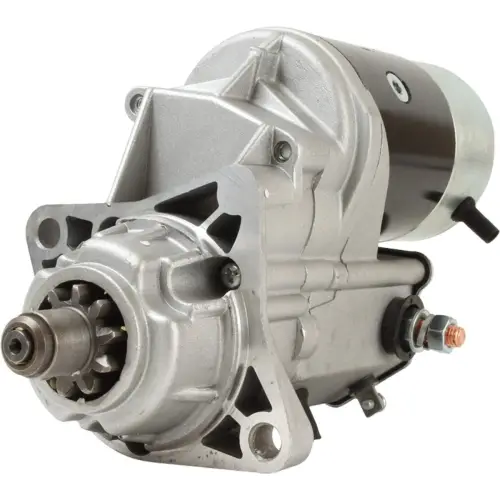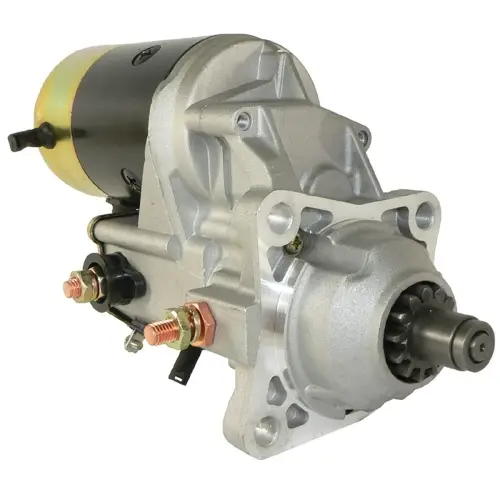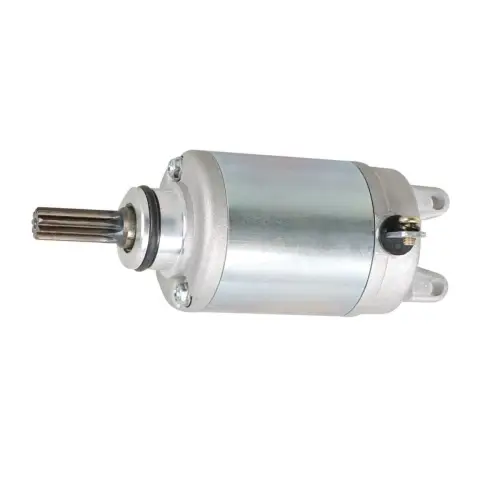How Does the Starter Motor Work and How to Fix It?
Learn how the starter motor works and discover effective methods for fixing it with our comprehensive guide. From understanding the basic mechanics to troubleshooting common issues, our expert tips will help you get your vehicle up and running in no time. Boost your automotive knowledge and get back on the road with confidence. Read more now.
What is a Starter Motor?
A starter motor is an essential component of an internal combustion engine, which is responsible for initiating the engine's operation. It is an electric motor starter that is designed to crank the engine by turning the flywheel at a high speed. The starter motor is typically mounted on the engine block, and it engages with the flywheel via a gear mechanism.
When a driver turns the ignition key, an electric current is sent to the starting motor, which in turn, spins the engine's flywheel. This spinning motion creates the necessary momentum to start the engine, and the process continues until the engine is running smoothly.
Starter motors are designed to be robust and reliable, as they need to endure the high loads and stresses that come with cranking an engine. They are typically made of durable materials, such as cast iron or aluminum, and are fitted with high-quality bearings and gears to ensure a smooth operation.
In addition to cranking the engine, starter motors are also equipped with a solenoid, which is responsible for engaging and disengaging the starter motor from the flywheel. The solenoid acts as an electromagnetic switch that connects the starter motor to the battery and ignition system.
There are several types of starter motors available on the market, including direct drive, gear reduction, and permanent magnet motors. Each type has its own advantages and disadvantages, depending on the engine's requirements and the vehicle's application.
In conclusion, a starter motor is a critical component of an internal combustion engine that enables the engine to start smoothly and efficiently. Without it, the engine would be unable to start, and the vehicle would be rendered immobile. Therefore, it is important to ensure that the starter motor is well-maintained and functioning correctly to avoid any potential issues or breakdowns.
The price of a starter motor can vary depending on several factors, including the make and model of the vehicle, the type of starter motor, and the retailer selling it. In general, a standard starter motor for a passenger car can range from $50 to $200, while a high-performance starter motor for a sports car or truck can cost upwards of $500 or more.
The price of a starter motor can also depend on whether it is new or refurbished. Refurbished starter motors can be a cost-effective option, but it's essential to ensure that they are of high quality and have been properly reconditioned before purchasing.
It's important to keep in mind that the cost of the starter motor is only one part of the overall cost of repairing or replacing a faulty starter system. Additional costs may include labor costs for installation, diagnostic fees, and the cost of any additional components needed, such as a starter solenoid or wiring.
To ensure that you are getting the best value for your money, it's important to compare starter motor price from multiple retailers and consider the reputation and customer reviews of the retailer and the product. It's also essential to ensure that the starter motor is compatible with your vehicle's make and model and meets the necessary specifications for your engine's requirements.
Where is the Starter Motor?
The starter motor is an essential component of an internal combustion engine, responsible for initiating the engine's operation. But where exactly is the starter motor located in a vehicle?
The location of the starter motor can vary depending on the make and model of the vehicle. In most cases, the starter motor is mounted on the engine block, close to the transmission bell housing. This location allows the starter motor to engage with the engine's flywheel and crank it to start the engine.
In some vehicles, especially those with front-wheel drive, the starter motor may be located on the side of the engine or under the intake manifold. In these cases, accessing the starter motor may require some disassembly of the engine components.
In addition, some high-performance vehicles may have the starter motor mounted on the transmission or even on the rear axle. This location can provide better weight distribution and help improve the vehicle's performance.
To locate the starter motor in your vehicle, you can consult the owner's manual or seek the advice of a qualified mechanic. They can help you identify the location of the starter motor and provide guidance on how to access it for maintenance or replacement.
It's essential to keep the starter motor in good working condition to avoid any potential issues or breakdowns. Regular maintenance, such as checking the electrical connections and cleaning the motor and gears, can help prolong the lifespan of the starter motor.
In conclusion, the location of the starter motor can vary depending on the vehicle's make and model, but it is typically mounted on the engine block near the transmission bell housing. Regular maintenance is crucial to ensure the starter motor is functioning correctly and avoid any potential issues or breakdowns.
How Does a Starter Motor Work?
When a driver turns the ignition key, an electric current is sent to the starter motor. The electric current flows through a series of electrical components, including the battery, ignition switch, and starter solenoid, before reaching the starter motor.
The starter motor is equipped with a powerful electric motor start that is designed to convert electrical energy into mechanical energy. The motor is typically made up of a stator and rotor, which are stationary and rotating components, respectively.
The rotor is connected to the engine's flywheel through a gear mechanism, and when the electric motor is activated, it spins the rotor at a high speed. This spinning motion creates the necessary momentum to turn the engine's flywheel and crank the engine, initiating the engine's operation.
The starter motor is also equipped with a solenoid, which is responsible for engaging and disengaging the starter motor from the engine's flywheel. The solenoid acts as an electromagnetic switch that connects the starter motor to the battery and ignition system.
When the ignition key is turned, the solenoid receives an electrical signal from the ignition switch, causing it to engage the starter motor's gear mechanism with the engine's flywheel. Once the engine is running smoothly, the solenoid disengages the starter motor from the engine's flywheel, and the engine is left to run on its own power.
There are several factors that can affect the performance of a starter motor, including the quality of the electrical components, the condition of the motor and gears, and the ambient temperature. Regular maintenance and inspection can help ensure that the starter motor is functioning correctly and avoid any potential issues or breakdowns.
How to Test a Starter Motor?
A starter motor is an essential component of an internal combustion engine that initiates the engine's operation. However, over time, the starter motor can experience wear and tear, and its performance can deteriorate, leading to engine starting issues. Testing the starter motor can help identify any potential issues and prevent unexpected breakdowns.
Here are some steps to test a starter motor:
Step 1: Check the Battery
Before testing the starter motor, ensure that the battery is fully charged and in good condition. A weak or discharged battery can cause starting issues and may prevent the starter motor from working correctly.
Step 2: Check the Electrical Connections
Inspect the electrical connections between the battery, starter motor, and ignition switch. Loose or corroded connections can affect the starter motor's performance and cause starting issues.
Step 3: Test the Starter Motor
To test the starter motor, use a multimeter to measure the voltage and amperage. Connect the multimeter's red lead to the starter motor's positive terminal and the black lead to the negative terminal. Then, turn the ignition key to the "Start" position and observe the multimeter's readings.
If the voltage reading is less than 10.5 volts, the battery may be weak, and the starter motor may not be receiving enough power. If the amperage reading is too high or too low, the starter motor may be faulty and need to be replaced.
Step 4: Check the Starter Solenoid
The starter solenoid is an essential component of the starter motor that engages and disengages the starter motor from the engine's flywheel. To check the starter solenoid, use a multimeter to measure the resistance between its terminals. If the resistance is out of the specified range, the starter solenoid may be faulty and need to be replaced.
How much does it cost to replace a start motor or fix it?
The starter motor replacement cost varies depending on the make and model of the vehicle and the location of the repair shop. Depending on a number of variables, including the make and model of your automobile, the seriousness of the issue, and where you live, the cost of replacing or repairing a starting motor can vary significantly. A new starting motor typically costs between $300 and $800, plus labour charges if you hire a mechanic to install it.
In addition to the starter motor, other components such as the starter solenoid, starter relay, or electrical connections may also need to be replaced, adding to the overall cost of the repair. The cost will vary depending on what the issue is with your current starter motor if you decide to fix it rather than replace it. Worn-out brushes, a malfunctioning solenoid, or a defective armature are a few typical starter motor issues. Repairing your starter motor could cost between $50 and $200, depending on the issue.It is essential to consult a professional mechanic to diagnose the issue accurately and provide an estimate for the replacement cost. Regular maintenance and inspection can help prolong the lifespan of the starter motor and prevent unexpected breakdowns, ultimately saving money on costly repairs.
Of course, it's generally a good idea to receive a price from a reliable professional before agreeing to any repairs. They can give you a more accurate estimate of what you would pay given your particular circumstances. It can be challenging to replace or repair a starter motor and requires specialised knowledge and tools. despite the temptation to try to save money by doing the work yourself. In order to guarantee that the task is done correctly and your car will start dependably, it is frequently preferable to leave it to the pros.
How to Fix Starter Motor Problems?
A faulty starter motor can cause engine starting issues and prevent your vehicle from starting altogether. However, many starter motor problems can be fixed with some basic troubleshooting and repairs. Here are some steps to fix starter motor problems:
Step 1: Check the Battery
A weak or discharged battery can cause starting issues and prevent the starter motor from working correctly. Check the battery's voltage and ensure that it is fully charged and in good condition.
Step 2: Check the Electrical Connections
Inspect the electrical connections between the battery, starter motor, and ignition switch. Loose or corroded connections can affect the starter motor's performance and cause starting issues. Clean the connections and ensure that they are tight and secure.
Step 3: Replace the Starter Solenoid
The starter solenoid is an essential component of the starter motor that engages and disengages the starter motor from the engine's flywheel. If the starter solenoid is faulty, it can prevent the starter motor from working correctly. Replace the starter solenoid if necessary.
Step 4: Clean or Replace the Starter Motor Brushes
Starter motor brushes can wear out over time and prevent the starter motor from working correctly. Remove the starter motor from the engine and inspect the brushes. If they are worn out, clean or replace them.
Step 5: Replace the Starter Motor
If the starter motor cannot be repaired, it may need to be replaced. Purchase a replacement starter motor that is compatible with your vehicle's make and model and follow the manufacturer's instructions for installation.
 Track Your Order
Track Your Order




